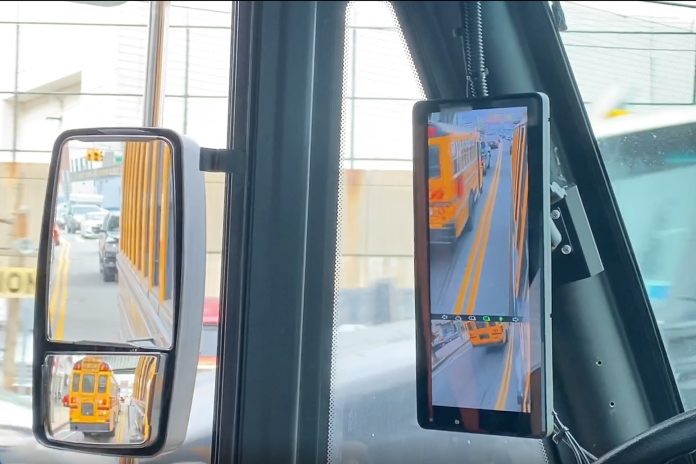The Federal Motor Carrier Safety Administration (FMCSA) is granting a limited five-year exemption to Rosco Vision System for after-market installation of its digital camera monitoring system (CMS) to enhance the driver’s field of vision.
A notice of final disposition and grant of exemption signed by FMCSA Administrator Robin Hutcheson was published Tuesday in the Federal Register. The exemption, one of several issued by FMCSA since 2019 for other similar CMS products, goes into effect Dec. 4 and expires on the same date in 2027.
The National Highway Traffic Safety Administration published an advance notice of proposed rulemaking on Oct. 10, 2019, that sought public comment on permitting CMS as an alternative to inside and outside rearview mirrors as original equipment. According to the rule timetable, the agency is expected to complete its analysis of the 666 public comments submitted by next month.
Rosco’s D-CAMS solution consists of three rear-vision video monitors showing split-screen images of different fields of view that extend down the sides of school buses and other vehicles, rather than conventional mirrors. Rosco petitioned FMCSA a year ago to grant a waiver for D-CAMS like has been done for several other products over the past few years. The agency responded last December by publishing a request for public comment.
According to the exemption filed for Docket No. FMCSA-2021-0186, Rosco’s CMS is firmly mounted at the top of a vehicle’s left and right A-pillar located between the windshield and the door or side of the cab. The CMS is enclosed in an aerodynamic package to provide environmental protection to the cameras.
In the exemption, FMCSA agreed with Rosco that D-CAMS “would likely achieve a level of safety equivalent to or greater than the level of safety” provided by current federal motor carrier safety regulations. FMCSA added that the installation of the equipment on the A-pillars creates no additional visual obstructions and eliminates “substantial blind spots” created by conventional mirrors.
The exemption also notes that D-CAMS includes interior viewing monitors with an ambient light sensor to prevent driver eye strain by dynamically adjusting screen brightness. The camera assemblies include an automatic heating system to prevent ice or moisture buildup on lenses. The internal monitors are located to reduce the upper-body range of motion by the driver, which FMCSA said reduces driver fatigue.
While evaluating whether to provide an exemption, FMCSA received four comments for and one against. But FMCSA said that it has also received “numerous positive comments in support of other, similar camera-based mirror exemptions.” Those benefits include superior total field of view, including the reduction or elimination of blind spots; increased night-time and inclement weather driving visibility at night or in inclement weather conditions; enhanced vehicle maneuverability when backing up, turning and changing lanes; and reduced driver fatigue.
FMCSA also noted that CMS meet the minimum safety, ergonomic and performance requirements of United Nations Economic Commission for Europe Regulation 46 as a legal alternative to traditional mirrors.
Those not in favor of an exemption questioned the reliability of CMS. FMCSA commented that a vehicle with a CMS camera or monitor failure would not be subject to an out-of-service order because it is not a critical inspection item under the Commercial Vehicle Safety Alliance out-of-service criteria, unlike conventional mirrors that are cracked or damaged while in operation. Instead, 49 CFR 396.11 requires the driver to complete a vehicle inspection report at the end of the shift and for the motor carrier to fix the safety defect before the driver is permitted to operate the vehicle again.
The exemption also requires drivers to inspect the CMS each time before operating the vehicle and at the conclusion of each shift to ensure the CMS is in working order. All defects must be noted, and the motor carrier must fix them before the vehicle can operate.
Motor carriers must also “periodically inspect” the CMS in addition to existing periodic inspections required by 49 CFR 396.17.
Meanwhile, fleets interested in installing the Rosco D-CAMS can do so with in-house staff. However, the company is recommending that its representatives directly assist with installs and training, said Peter Plate, vice president of sales and marketing for Rosco Vision Systems.
Related: FMCSA Passes Two Year ‘Under-the-Hood’ CDL Skills Test Exemption, Opposition Remains
Related: Pending FMCSA Notices of Proposed Rulemaking Include Driver Fitness, Speed Limiters
Related: NTSB Investigation of Fatal Tennessee School Bus Crash Reiterates Seatbelt Calls
Related: NTSB’s Alcohol Impairment Detection Recommendation More Nuanced for School Bus Drivers
Related: Collision-Avoidance Among NTSB’s Most Wanted Safety Features, OEMS Weigh In














